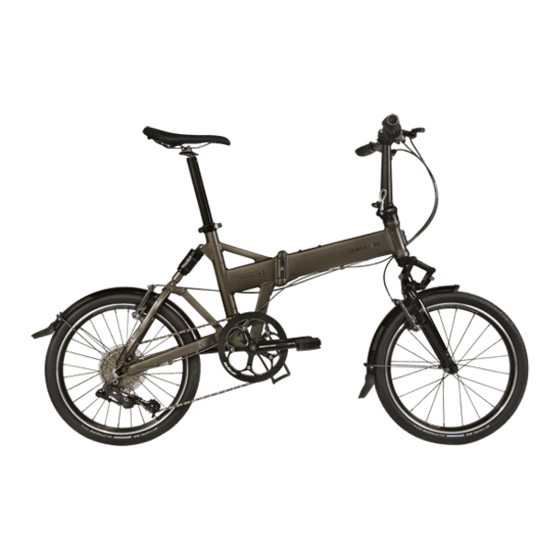DAHON - 2010 Kullanıcı El Kitabı - Sayfa 9
Bisiklet DAHON - 2010 için çevrimiçi göz atın veya pdf Kullanıcı El Kitabı indirin. DAHON - 2010 20 sayfaları.
Ayrıca DAHON - 2010 için: Manuel (2 sayfalar), Manuel (2 sayfalar), Manuel (2 sayfalar), Manuel (2 sayfalar), Manuel (2 sayfalar), Manuel (2 sayfalar)

Brakes – Rim Brakes & Disc
Brakes
Riding with improperly adjusted brakes or worn
brake pads is dangerous and can result in seri-
ous injury or death.
Applying brakes too hard or too suddenly can
lock up a wheel, which could cause you to lose
control and fall. Sudden or excessive applica-
tion of the front brake may pitch the rider over
the handlebars, which may result in injury or
death.
Some bicycle brakes, such as disc brakes and
linear-pull brakes, are extremely powerful. Ex-
ercise particular care when using them.
Disc brakes can get extremely hot with extend-
ed use. Be careful not to touch a disc brake
until it has had plenty of time to cool.
See the manufacturer's instructions for opera-
tion and care of your brakes. If you do not have
manufacturer instructions, call your dealer or
the brake manufacturer.
Brake Controls and Features
It's very important to learn and remember
which brake lever controls what brake. Your
bike will come already set and adjusted so that
the right brake lever controls the rear brake.
The left lever controls the front brake. Make
sure your hands can reach and squeeze the
brake levers.
NOTE: In the UK and Japan, the right lever
controls the front brake while the left lever
controls the rear brake. All brakes should be
adjusted according to local regulations.
How Brakes Work
The action of a rim-actuated brake on a bi-
cycle is a function of the friction between the
brake surfaces — usually the brake pads and
the wheel rim. To make sure that you have
maximum friction available, keep your wheel
rims and brake pads clean and free of dirt,
lubricants, waxes or polishes. Another impor-
tant bicycle brake is a disc brake. To install
disc brakes, special disc brake mounts on the
frame and fork and special hubs are necessary.
These brakes are small and rely on brake pads
that squeeze both sides of a small disc rotor
that is mounted on each wheel. Disc brakes
are quite resistant to weather and provide very
strong stopping power on steep hills or on wet
terrain and are well suited for heavy riders.
Brakes are designed to control your speed, not
just to stop the bike. Maximum braking force for
each wheel occurs at the point just before the
wheel "locks up" (stops rotating) and starts to
skid. Once the tire skids, you actually lose most
of your stopping force and completely lose
directional control.
NOTE: Make sure that no oil or lubrication
touches your brake pads or the bicycles rims'
braking surfaces. Please replace worn brake
shoes only with factory authorized brake
replacements.
9
